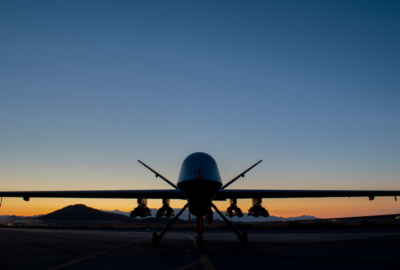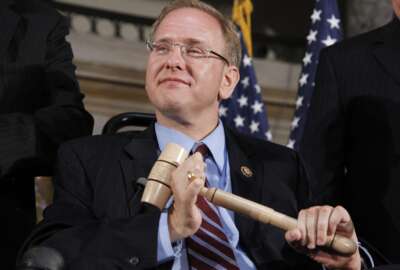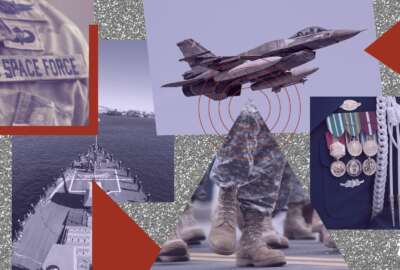
Air Force Association celebrates 75 year anniversary
As it celebrates 75 years in business, the Air Force Association deals with a service facing a lot of challenges. With an update, the chair of the board, Gerald...
Best listening experience is on Chrome, Firefox or Safari. Subscribe to Federal Drive’s daily audio interviews on Apple Podcasts or PodcastOne.
The Air Force Association is actually older than the Air Force itself. As it celebrates 75 years in business, the Association deals with an Air Force facing a lot of challenges. With an update, the chair of the board of the Air Force Association, Gerald Murray, joined Federal Drive with Tom Temin.
Interview transcript:
Tom Temin: Mr. Murray, good to have you on.
Gerald Murray: Great to be with you, thank you.
Tom Temin: I was surprised to find that the association is at least by a few months older than the Air Force. Give us the history there.
Gerald Murray: Yes, the Air Force is we know was created in 1947 was the official date when it was declared separated from the United States Army. The year prior to that, and actually about two years prior to that was when General Hap Arnold, who was the commander of the Army Air Corps at the time, decided that he needed a separate organization to be able to support and advocate for the Department of the Air Force and thus directed the creation there, if you will, of the Air Force Association, and ask general Jimmy Doolittle, Medal of Honor recipient, if he would take the lead. And then from that began the creation and all. And then our incorporation was in the District of Washington on February the 4th 1946.
Tom Temin: Got it. So the association was there and ready when the Air Force itself was officially declared, it already had an association to help, as you say, advocate and make sure it got the resources it needed.
Gerald Murray: That’s correct. Much of that goes back even earlier than that. In fact, we look at the fact that General Billy Mitchell, who we know was a such a strong proponent after World War I , is who we look at is really the creation and the advocating so strongly for a separate forces there. Was actually then after that that General Arnold actually took the action. And the first thing he did was actually taken separate a magazine that had been supporting the Army Air Corps and move it out and provide it to the civilian organization that really started this. Also the great magazine we continue to have today, the Air Force Magazine itself. So that was really the formation of it, of having the ability to educate, communicate. And a big part of it, too, is that if you go back into World War I I , the separations of tens of thousands, really closer to a million airmen that had served so gallantly in World War I I . A big part of it, too, is the opportunity to have an organization as Jimmy Doolittle said, to keep the gang together. So it really started the grassroots aspect of this, to be able across America to have an organization that fellow airmen could join together in, and at the same time to take on a mission of continuing to be the supporters for the young Air Force that has continued to date. We’re the voice if you will in strong proponents of both the Air and the Space Forces with the creation of the new Space Force today.
Tom Temin: Yeah, that points to a big issue here, in the late 40s the Air Force was just beginning to deal with jet propulsion, much less space. And today, of course, it’s obviously all jets, well mostly, there’s still a few props here and there. And, of course, as you mentioned, space, and so from the standpoint of the association, what are the big challenges the Air Force itself has, as we enter the middle, I guess, almost of the 21st century?
Gerald Murray: Well, clearly from a Department of Air Force today, it is now birthing the new Space Force, a young force, and so much to be able to do. Really at the hub of that of course now is taking what has been a single budget, if you will, and now seeing it being able to be divided, and has been through by command structure, but now is really a daunting aspect of being able to take a budget with a single military department, understand the need to be able to recapitalize the forces. And we’ve been talking for a long time really since the late 1990s and early 2000s, about the Air Force itself has been flying the oldest aircraft in their history, that need for recapitalization is still there. I mean, we’re seeing now things like the new B-21, bomber, newer aircraft and all. But at the same time we’re still flying B-52s out there that were developed back in the 1950s. In fact, I think, a couple of them maybe still flying since then. So you take that, the tankers, the F-16s, and others are there, so really taken ability to recapitalize that fleet. The other side of that is that it’s the fewest aircraft that the Air Force has ever had. But at the same time, the need to invest in smarter capabilities, invest in our people and our families, command and control — and then you take it over into space. There’s a need to innovate and to be able to continue to be able to develop and stay ahead of our enemies or potential enemies and those fears out. There are just huge challenges that where we need to be able to have the right resources for both our Air and our Space Force in the Department of the Air Force. Today,
Tom Temin: And you had an Air Force career yourself, so you have been on the inside. What does it take to be a outstanding airman in this century?
Gerald Murray: Well, I will tell you, it starts at one of the heart of what we do is that the education, it’s that professional development. You have a short span of time, and I can say today with 30 years of service time, and beyond that that timeframe is a continued development of of individuals capabilities of being able to have the things that motivate airmen to be able to serve. But it’s about developing and making sure that we have the most developed, highly trained, skilled forces that we can possibly have in the services today. That’s what we advocate for and that’s what we do through the multiple avenues that we have, through our forums, our conferences, symposiums. We continue to do that, in ways that helps the Air Force and Space Force develop the most capable airmen that we can have in the service.
Tom Temin: And what kind of work do you do on the Hill because ultimately, that’s where the money decisions get made — and to some degree, the force size, and other operational decisions can get made? How do you interact up there?
Gerald Murray: It’s education. Our advocacy is one of to being able to, one, build relationships. We all recognize how important relationships are. And so as we work hard to be able to have relationships with our congressional leaders across the nation, with their staffers there, is to be able to inform them, if you will, again about the needs of our Air and Space Forces. So as we continue to do that on the Hill is, again, helping to get the word out to them, and to help them understand why the need of the forces are so important.
Tom Temin: And a constant for all of the Armed Services is the need to recruit and retain, but you can’t retain until you can recruit. And so what’s your best selling point for someone, the young man or woman that decides, maybe the Air Force is for me?
Gerald Murray: I think it’s about service, service to our nation. Of course, youngsters in a lot of ways they want to look at pay, benefits that they get. The education benefits are very important, of course, as provided that our congressional leaders have always supported in a great way. And so those are things, but the other is is that the know how important it is to have and provide service to our nation. The other is across all of our services, not only do we need great airman and guardians, but the same thing of soldiers, sailors, Marines, Coast Guardsmen and others, and even the civilians to serve our nation. I think that’s the thing that is most important to always put at the forefront of how important it is to provide service to our nation.
Tom Temin: Gerald Murray is chairman of the board of the Air Force Association. Thanks so much for joining me and best luck on the next 75 years.
Gerald Murray: Well, thank you very much. It’s an absolute pleasure to be with you and I appreciate the opportunity for the Air Force Association to tell our story just a little bit as well.
Copyright © 2025 Federal News Network. All rights reserved. This website is not intended for users located within the European Economic Area.
Tom Temin is host of the Federal Drive and has been providing insight on federal technology and management issues for more than 30 years.
Follow @tteminWFED





